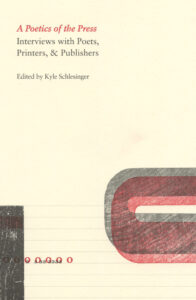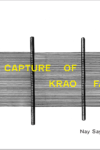
[Ugly Duckling Presse; 2021]
In “‘Power to the people’s mimeo machines!’ or the Politicization of Small Press Aesthetics,” the first of a trenchant four-part essay for Harriet, Matvei Yankelevich, co-founder of Ugly Duckling Presse, traced the history of the small press movement, central to which is an aesthetics of resistance. “Small press,” he wrote, “has historically defined itself foremost by its autonomy, by being editor-run, anti-institutional, and anti-commercial. It marked the story of its autonomy by an aesthetic of ‘authenticity’ created through a variety of means: the use of cheap or obsolete technologies, experimental or anti-aesthetic design, unremunerated labor, and alternative systems of distribution.” One of these obsolete technologies is letterpress printing. Co-published by Cuneiform Press and Ugly Duckling Presse, A Poetics of the Press gathers interviews with sixteen small presses, with a focus on the material aspects of publishing, and letterpress printing in particular. Arranged chronologically, the interviews cover six decades, from the “mimeo revolution” of the 1960s to the present. (As Yankelevich argued, quoting the poet Loss Pequeño Glazier, “‘the mimeo revolution’ is more a metaphor for inexpensive means of reproduction than a commitment to any one technology.”) Compiled and edited by Kyle Schlesinger of Cuneiform Press, the book is in some ways a companion piece to Alastair Johnston’s Hanging Quotes, “an oral history project comprised of nineteen interviews with pioneer book artists, typographers, and poets,” published by Cuneiform in 2011.
Conducted over the last thirteen years, the interviews are with: Keith and Rosmarie Waldrop of Burning Deck Press, Tom Raworth of Matrix Press and Goliard Press, Lyn Hejinian of Tuumba Press, Alan Loney of Electio Editions, Mary Laird of Quelquefois Press and the Perishable Press Limited, Jonathan Greene of Gnomon Press, Alastair Johnston of Poltroon Press, Johanna Drucker of Druckwerk, Philip Gallo of the Hermetic Press, Steven Clay of Granary Books, Charles Alexander of Chax Press, Annabel Lee of Vehicle Editions, Inge Bruggeman of INK-A! Press, Anna Moschovakis and Matvei Yankelevich of Ugly Duckling Presse, Aaron Cohick of NewLights Press, and Scott Pierce of Effing Press. Each interview is prefaced with a capsule biography and modestly illustrated with black-and-white reproductions of printed matter. Apart from Clay, each of the interviewees is, like the interviewer himself, a poet and printer and publisher. “I often think of printing and writing as harmonized, sometimes wonderfully dissonant histories,” Schlesinger says. The New Zealand poet Alan Loney puts it this way: “The form of the poem and the form of the book overlap, intersect, interfere, overlay each other in the pleasure of the work, and the layers or degrees of openness required for that to happen have not in my experience come easily, nor can they be taken for granted.” Generous and wide-ranging, the conversations revolve around this quicksilver relationship. Discussions of poetry alternate with printing shoptalk and gossip, capturing the social texture of the small press movement and book arts boom. Lots of books are mentioned; some provoke textual commentary and stories about the collaborative work of publishing. Schlesinger gets into the nitty-gritty details of printing letterpress: press types and sizes, fonts and paper, compositor’s tools. (A handy glossary of names and printing terms is appended to the book. Do you know what a Vandercook Universal I is? A hellbox?) Most of the men can’t seem to help but reminisce about manly behavior: stealing methamphetamines, working the night shift at a factory, disappearing off to Africa, gambling in honky-tonks, drunkenly brawling, sleeping it off in the print shop.
It all makes for a vivid oral history across generations and geographies. Friendships and literary affinities, and some lingering enmities, connect the interviews. The usual gallery of earlier small presses and self-published authors is invoked: Walt Whitman, the Yeats’ Cuala Press, Shakespeare and Company, the Hogarth Press, Anaïs Nin’s Gemor Press. By now, Burning Deck and Tuumba, the first two of the American presses included, enjoy a comparable renown. Something Else Press and Ed Ruscha’s cheap democratic multiples remain the lodestar for artists books, but, rightly or wrongly, there’s a sense here that publishing in the arts, with Printed Matter in New York as its hub, is basically a field apart. (As Steven Clay remarks, “Everything that Granary was about was almost self-evident to the poets, while it caused a lot of head scratching from the art world.”) Sometimes this lineage is given conceptual form: NewLights’s first publication was Aaron Cohick’s The Collected Books of Jack Spicer, a found poem that faithfully reproduces Spicer’s bibliography, and The New Manifesto of the NewLights Press borrows a William Morris title page design. For Ugly Duckling Presse, the eclecticism of their catalog — “no two books are designed alike” — aligns them with legendary small presses such as The Jargon Society and Coracle. What emerges is the ideal of a nonconformist, nonhierarchical approach to publishing, spontaneous and attentive to immediate social concerns. This arguably fosters writing that is “involved in some way with crossing traditional genre boundaries,” as Lyn Hejinian describes Atelos’s catalog, “including, for example, those that would separate theory from practice, poetry from prose, essay from genre, the visual image from the verbal, the literary from the non-literary, and so forth.” Taken together, these sixteen presses have seen an astounding wealth of literature into print. It’s fascinating to hear about the early publications of Robert Duncan, Lucia Berlin, and Anne Tardos, among others, and tantalizing to hear about work in progress — I particularly look forward to reading Johanna Drucker’s Poetry Wars, “which traces the lived history of avant-garde poetry through a roman à clef from 1975 to the present.”
The focus on letterpress becomes more unusual as the book catches up to the present. For his part, Schlesinger took up printing letterpress in the late 1990s — “we printed the literary review for Goddard College, instructions for using a compost toilet, Gertrude Stein stationery, and a few short poems,” he has recalled — and established Cuneiform Press in 2000. The interviews began as an extension of his research into “the relationship between poetry, typography, and visual art in books printed by hand in America between the end of the Second World War and the end of the Vietnam War.” The start of this period coincides with the widespread adoption of offset printing; because of the new, more efficient printing technology, letterpress equipment became relatively easy to acquire second-hand. Recalling the early 1960s, British poet Tom Raworth tells Schlesinger, “the cheapest way [to do a magazine] then was, ridiculously, to learn to set type and to print.” Hejinian and Keith and Rosmarie Waldrop famously started their presses at home, using letterpress equipment — “not for any aesthetic reason, but because that equipment was ‘useless.’” As the economies of printing changed in the 1970s and 80s, this commercially obsolete technology was primarily associated with fine printing: expensive limited editions, made for institutions and collectors. As anyone who has ever set type by hand will know, it is a slow and laborious process. You feel the weight of each unit of language; you are bodily involved with composition. Today, as Yankelevich pointed out in his Harriet essay, printing letterpress is especially provocative as a willfully uneconomic gesture. He gave the example of Michael Cross, who established Compline Books at his home in Oakland in 2009. Cross, who appears twice as co-interviewer in A Poetics of the Press, explained his use of letterpress in terms of inconvenience: “When I begin making a book, I enter into a relationship with privation . . . This negativity, I suppose, is one way to resist our culture’s demand for convenience and immediacy. It’s a kind of holding out. Insisting on silence and difficulty, which to me is truth.”
An excellent interviewer, Schlesinger is less vocally radical than Cross. “As works of art, contemporary fine press editions are underestimated in terms of their monetary value,” he tells Loney. And: “I want to preserve the handmade qualities of the printed book.” Why this should be a desirable quality is not fully explained. There’s some polemical talk about the distinctions between small press, fine press, book arts, livres d’artiste, and artists books (“a still-contested term”), which is illuminating, but the interest is in the overlap between these terms, or their elasticity. Suffice to say that of the sixteen presses, there are several, following Walter Hamady of the Perishable Press, that have embraced craft, aspiring to make a connection “between the heritage of fine printing and the graphic discoveries of the current century.” And several, following Hejinian, that have resolutely sought to undermine the commodity value of poetry. Sometimes the two positions intersect, and sometimes they’re are at variance with each other — as Yankelevich rightly asks, “What happens to a book when it becomes a fetish object?” One commonality between these publishers is letterpress. Another, related commonality, expressed by Charles Alexander, is their autonomy and transformative potential, to which this beautiful book is a testament: “Part of the reason for being involved in poetry, part of the reason for starting journals, part of the reason for starting presses, part of the reason for talking to you sitting on this bench right now, is all about building something together. We’re not necessarily always conscious of just what we are building, but the language we work with is social material. We share it and we build relationships and ultimately other kinds of community.”
Louis Lüthi is the author of On the Self-Reflexive Page (Roma Publications, 2010; second edition, fall 2021), Infant A (Paraguay Press, 2012), and A Die with Twenty-Six Faces (Roma Publications, 2019). He teaches at the Gerrit Rietveld Academie in Amsterdam, the Netherlands.
This post may contain affiliate links.







